Ductile Fracture Investigation of High-Strength Steel SM570 under Low Stress Triaxiality
Abstract
1. Introduction
2. Specimens and Loading Method
3. Experimental Results and Discussion
3.1. Load-Displacement Curves
3.2. Fracture Failure and Failure Surface
4. Numerical Model for Fracture Behavior
4.1. FE Model
4.2. Material Model
5. Ductile Fracture Model and Simulation Results
5.1. Applicability of the Existing Fracture Models
5.2. Modified N-VG Model and Simulation Results
6. Conclusions
- (1)
- As the notch angle varies from 45° to −30, δmax and δf of SYM-Shear and USYM-Shear specimens increase gradually. As the shear band transits from the combined shear-compression stress state to the combined shear-tension stress state, the strength of the SM570 steel is remarkably reduced, resulting in early fracture. In addition, SYM-Shear specimens showed larger values of δf and higher load-bearing capacity than USYM-Shear specimens.
- (2)
- Comparison between the SM570 and the ordinary steel SM490 demonstrates that fracture failure occurs earlier in the SM570 specimens. δmax of the conventional steel SM490 specimen is approximately equal to twice the δmax of the steel SM570 specimen. It is attributed to the low plastic deformation capacity of the SM570, which leads to the strain concentration at the notch and the earlier crack initiation, while the SM490 specimens encounter ductile fracture failure, accompanied by large plastic deformation.
- (3)
- A modified N-VG model with a quadratic polynomial fracture criterion in the stress triaxiality range from −0.6 to 1/3 was proposed. Numerical analyses using the modified model were performed with ABAQUS to simulate the fracture behavior of the SYM-Shear and the USYM-Shear specimens. The maximum load error between the numerical results and the test results is within 10%, while the corresponding displacement error is almost within 20%.
Author Contributions
Funding
Institutional Review Board Statement
Informed Consent Statement
Data Availability Statement
Acknowledgments
Conflicts of Interest
References
- Sugimoto, H.; Takahashi, Y. Investigation of beam-column-connection surface fractures that occurred during the 1995 Hanshin-Awaji earthquake and repair welding heat effect on adjacent steel: Inspection of crack growth and analysis of material degeneration. Steel Constr. Eng. 1995, 3, 21–34. (In Japanese) [Google Scholar]
- Watanabe, E.; Maekawa, Y.; Sugiura, K.; Kitane, Y. Damage and seismic performance of steel bridges. Civ. Eng. JSCE 1995, 80, 54–62. (In Japanese) [Google Scholar]
- Okashita, K.; Ohminami, R.; Michiba, K.; Yamamoto, A.; Tomimatsu, M.; Tanji, Y.; Miki, C. Investigation of the brittle fracture at the corner of P75 rigid-frame pier in Kobe harbor highway during the Hyogoken-Nanbu earthquake. J. Struct. Mech. Earthq. Eng. 1998, 591, 243–261. (In Japanese) [Google Scholar] [CrossRef]
- Hiramatsu, H.; Michiba, K.; Toyoda, M. Ductile crack initiation behavior of structural materials under low stress triaxiality. J. Soc. Nav. Archit. Jpn. 2002, 192, 563–571. (In Japanese) [Google Scholar] [CrossRef]
- Ge, H.; Kawahito, M.; Ohashi, M. Fundamental study on ductile crack initiation condition in structural steels considering micro-void growth. Proc. JSCE Earthq. Eng. Symp. 2005, 28, 190. (In Japanese) [Google Scholar]
- Tamaru, H.; Sasaki, E.; Yamada, H.; Katsuchi, H. Analytical study focusing on stress triaxiality on factor of brittle fracture during earthquake in steel bridge bents. J. Jpn. Soc. Civ. Eng. A 2010, 66, 420–434. (In Japanese) [Google Scholar]
- Xiang, P.; Jia, L.; Ke, K.; Chen, Y.; Ge, H. Ductile cracking simulation of uncracked high strength steel using an energy approach. J. Constr. Steel Res. 2017, 138, 117–130. [Google Scholar] [CrossRef]
- Bao, Y.; Wierzbicki, T. On fracture locus in the equivalent strain and stress triaxiality space. Int. J. Mech. Sci. 2004, 46, 81–98. [Google Scholar] [CrossRef]
- Bai, Y.; Wierzbicki, T. A new model of metal plasticity and fracture with pressure and load dependence. Int. J. Plast. 2008, 24, 1071–1096. [Google Scholar] [CrossRef]
- Rice, J.R.; Tracey, D.M. On the ductile enlargement of voids in triaxial stress field. J. Mech. Phys. Solid 1969, 17, 201–217. [Google Scholar] [CrossRef]
- Barsoum, I.; Faleskog, J. Rupture mechanisms in combined tension and shear—Experiments. Intern. J. Solids Struct. 2007, 44, 1768–1786. [Google Scholar] [CrossRef]
- IS G 3106:2015; Rolled Steels for Welded Structure. Japan Industrial Committee: Tokyo, Japan, 2015.
- Liu, Y.; Ge, H.; Kang, L. A study on the improvement of the simulation accuracy of ductile fracture model for structural steels under high stress triaxiality. J. Jpn. Soc. Civ. Eng. Ser. A1 2018, 74, 546–557. (In Japanese) [Google Scholar] [CrossRef]
- Liu, Y.; Ge, H.; Kang, L. A study on developing a ductile fracture model for structural steels under low stress triaxiality. J. Jpn. Soc. Civ. Eng. Ser. A1 2019, 75, 333–344. (In Japanese) [Google Scholar] [CrossRef]
- Liu, Y.; Kang, L.; Ge, H. Experimental and numerical study on ductile fracture of structural steels under different stress states. J. Constr. Steel Res. 2019, 158, 381–404. [Google Scholar] [CrossRef]
- Miki, C.; Ichikawa, A.; Kusunoki, T.; Kawabata, F. Proposal of new high performance steels for bridges (BHS500, BHS700). J. Jpn. Soc. Civ. Eng. 2003, 738, 1–10. (In Japanese) [Google Scholar] [CrossRef][Green Version]
- Ono, Y.; Kinoshita, K. Bridge weight reduction effect of the hybrid girder using SBHS700. Proc. Constr. Steel 2016, 24, 536–541. (In Japanese) [Google Scholar]
- Hirohata, M.; Teraguchi, D.; Kitane, Y. Mechanical properties of steels for bridge high performance structures subjected to heating and cooling process simulating fire. Steel Constr. Eng. 2019, 26, 79–86. (In Japanese) [Google Scholar]
- Liu, Y.; Ikeda, S.; Liu, Y.; Kang, L.; Ge, H. Experimenal investigation of fracture performances of SBHS500, SM570 and SM490 steel specimens. Metals 2022, 12, 672. [Google Scholar] [CrossRef]
- Gao, X.; Zhang, G.; Roe, C. A study on the effect of the stress state on ductile fracture. Int. J. Damage Mech. 2010, 19, 75–94. [Google Scholar]
- Lu, J.; Liu, H.; Chen, Z.; Liao, X. Experimental investigation into the post-fire mechanical properties of hot-rolled and cold-formed steels. J. Constr. Steel Res. 2016, 121, 291–310. [Google Scholar] [CrossRef]
- Cao, T.S.; Gachet, J.M.; Montmitonnet, P.; Bouchard, P.-O. A lode-dependent enhanced Lemaitre model for ductile fracture prediction at low stress triaxiality. Eng. Fract. Mech. 2014, 124–125, 80–96. [Google Scholar] [CrossRef]
- Li, W.; Liao, F.; Zhou, T.; Askes, H. Ductile fracture of Q460 steel: Effects of stress triaxiality and load angle. J. Constr. Steel Res. 2016, 123, 1–17. [Google Scholar] [CrossRef]
- Kubík, P.; Šebek, F.; Hůlka, J.; Petruška, J. Calibration of ductile fracture criteria at negative stress triaxiality. Int. J. Mech. Sci. 2016, 108–109, 90–103. [Google Scholar] [CrossRef]
- Dunand, M.; Mohr, D. Effect of load parameter on plastic flow localization after proportional loading at low stress triaxialities. J. Mech. Phys. Solids 2014, 66, 133–153. [Google Scholar] [CrossRef]
- Kweon, S. Damage at negative triaxiality. Eur. J. Mech.-A/Solids 2012, 31, 203–212. [Google Scholar] [CrossRef]
- Kiran, R.; Khandelwal, K. A triaxiality and load parameter dependent ductile fracture criterion. Eng. Fract. Mech. 2014, 128, 121–138. [Google Scholar] [CrossRef]
- Wen, H.; Mahmoud, H. Simulation of block shear fracture in bolted connections. J. Constr. Steel Res. 2017, 134, 1–16. [Google Scholar] [CrossRef]
- Wen, H.; Mahmoud, H. New model for ductile fracture of metal alloys. I: Monotonic loading. J. Eng. Mech. 2016, 142, 4015088. [Google Scholar] [CrossRef]
- Lou, Y.; Yoon, J.W.; Huh, H. Modeling of shear ductile fracture considering a changeable cut-off value for stress triaxiality. Int. J. Plast. 2014, 54, 56–80. [Google Scholar] [CrossRef]
- Bacha, A.; Daniel, D.; Klocker, H. Metal ductility at low stress triaxiality application to sheet trimming. J. Mater. Processing Technol. 2008, 203, 480–497. [Google Scholar] [CrossRef]
- Bao, Y.; Wierzbicki, T. On the cut-off value of negative triaxiality for fracture. Eng. Fract. Mech. 2005, 72, 1049–1069. [Google Scholar] [CrossRef]
- Li, H.; Fu, M.; Lu, J.; Yang, H. Ductile fracture: Experiments and computations. Int. J. Plast. 2011, 27, 147–180. [Google Scholar] [CrossRef]
- JIS G 3140:2011; Higher Yield Strength Steel Plates for Bridges. Japan Industrial Committee: Tokyo, Japan, 2011.
- Kang, L.; Ge, H.; Kato, T. Experimental and ductile fracture model study of single-groove welded joints under monotonic loadings. Eng. Struct. 2015, 85, 36–51. [Google Scholar] [CrossRef]
- Yun, L. Uniaxial true stress-strain after necking. AMP J. Technol. 1996, 5, 37–48. [Google Scholar]
- Jia, L.; Kuwamura, H. Ductile fracture simulation of structural steels under monotonic tension. J. Struct. Eng. 2014, 150, 4013115. [Google Scholar] [CrossRef]
- Shinohara, K.; Jia, L.; Kato, H.; Ge, H. A study on ductile fracture mechanism of structural steels under combined shear and tensile stresses. J. Jpn. Soc. Civ. Eng. Ser. A1 2015, 71, 337–348. (In Japanese) [Google Scholar]
- Hancock, J.W.; Mackenzie, A.C. On the mechanisms of ductile failure in high-strength steels subjected to multi-axial stress-states. J. Mech. Phys. Solids 1976, 24, 147–169. [Google Scholar] [CrossRef]
- Johnson, G.R.; Cook, W.H. Fracture characteristics of three metals subjected to various strains, strain rates, temperatures and pressures. Eng. Fract. Mech. 1985, 21, 31–48. [Google Scholar] [CrossRef]



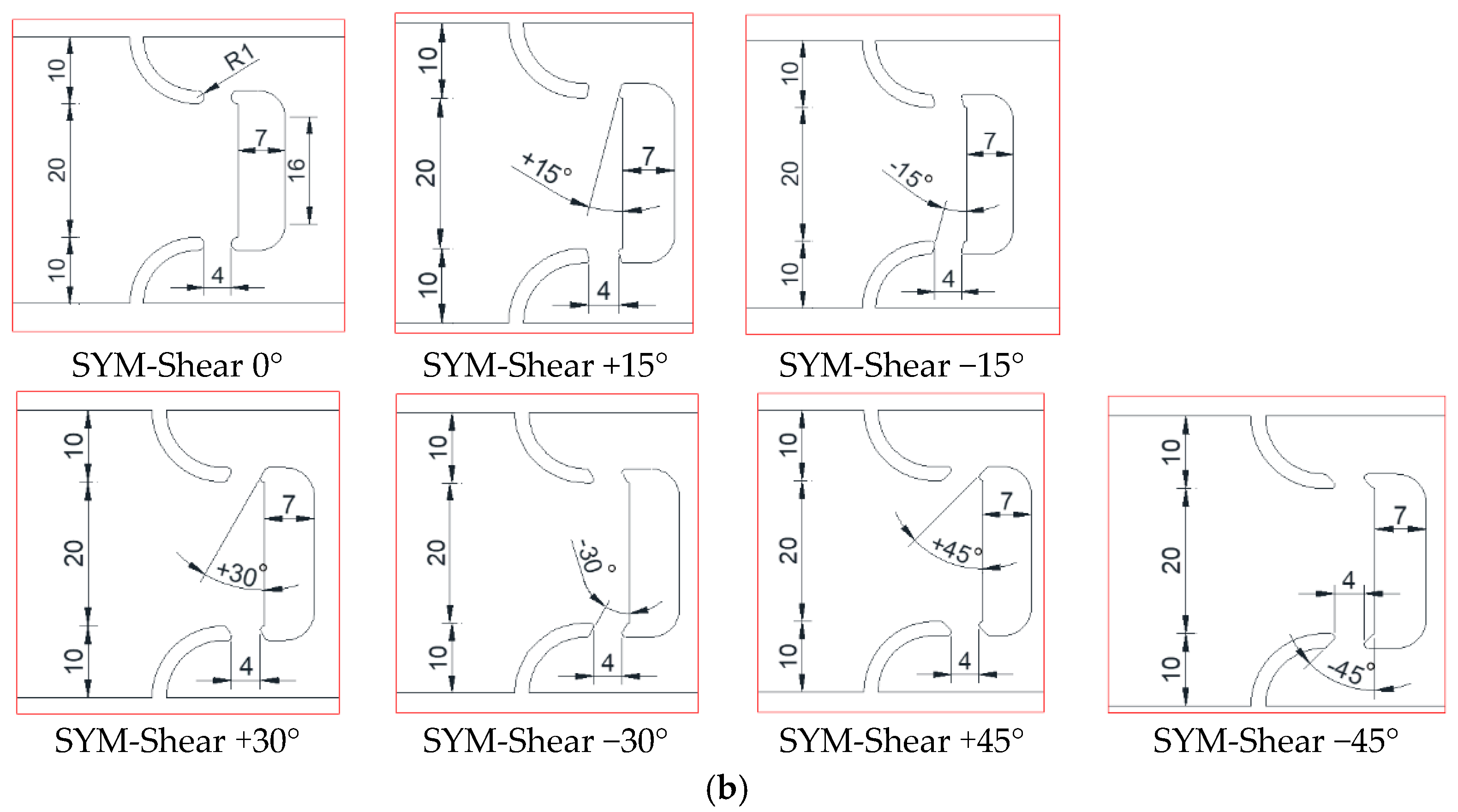

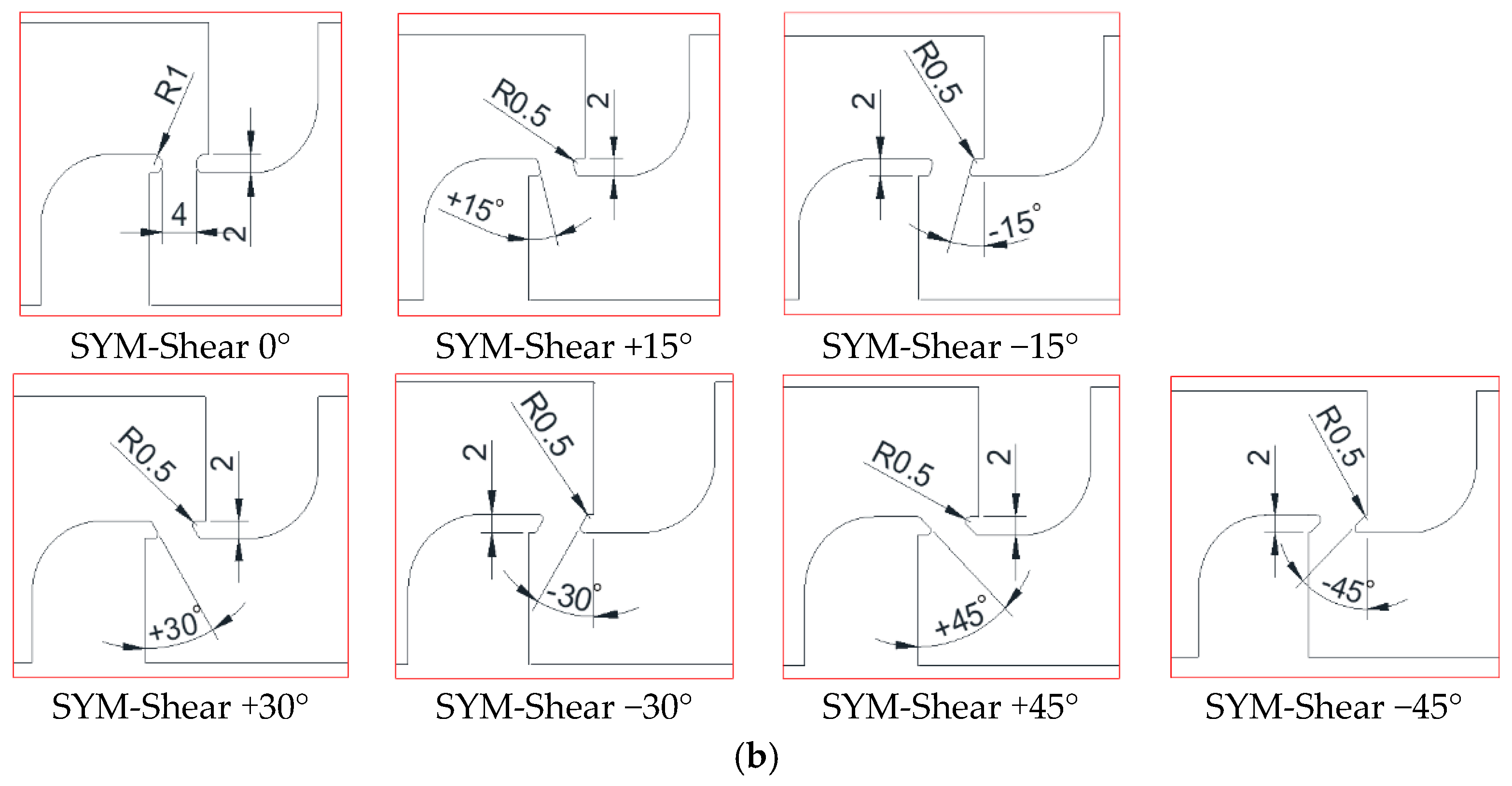
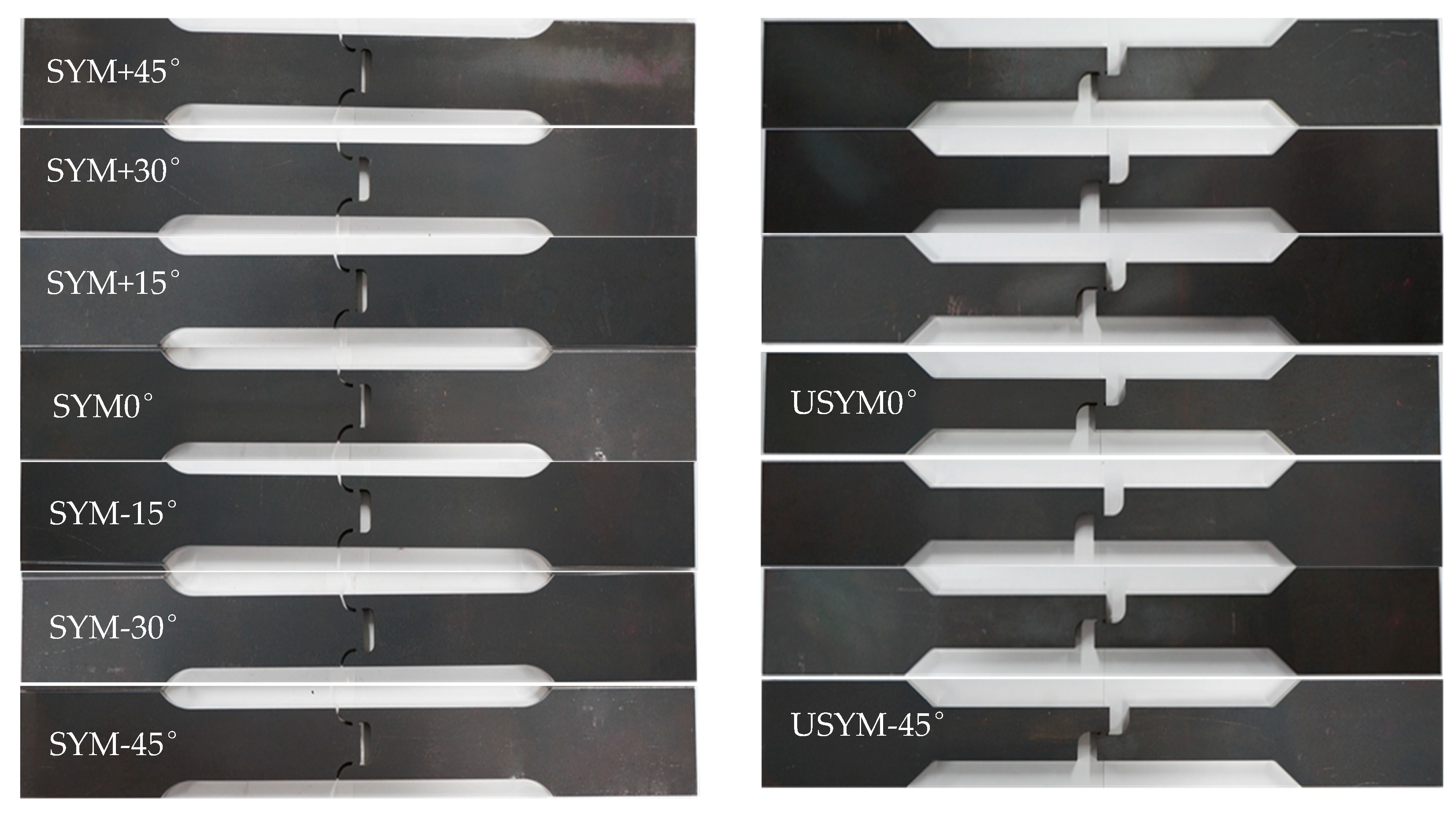


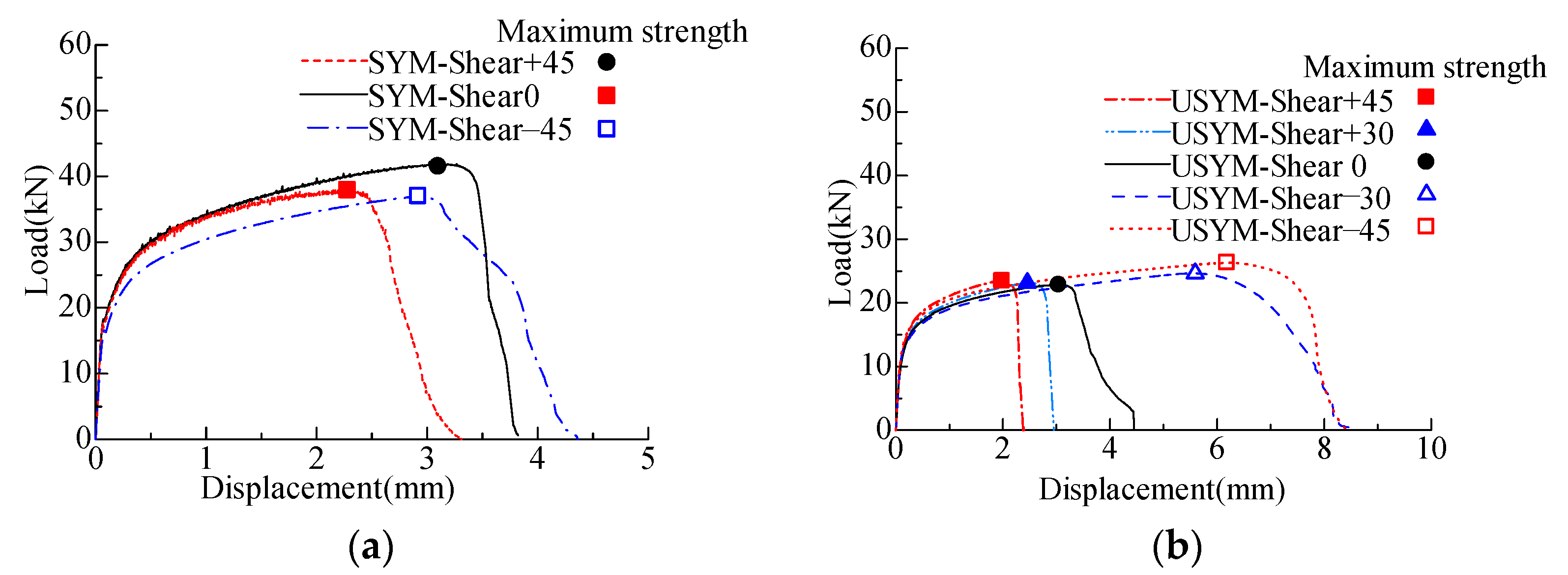

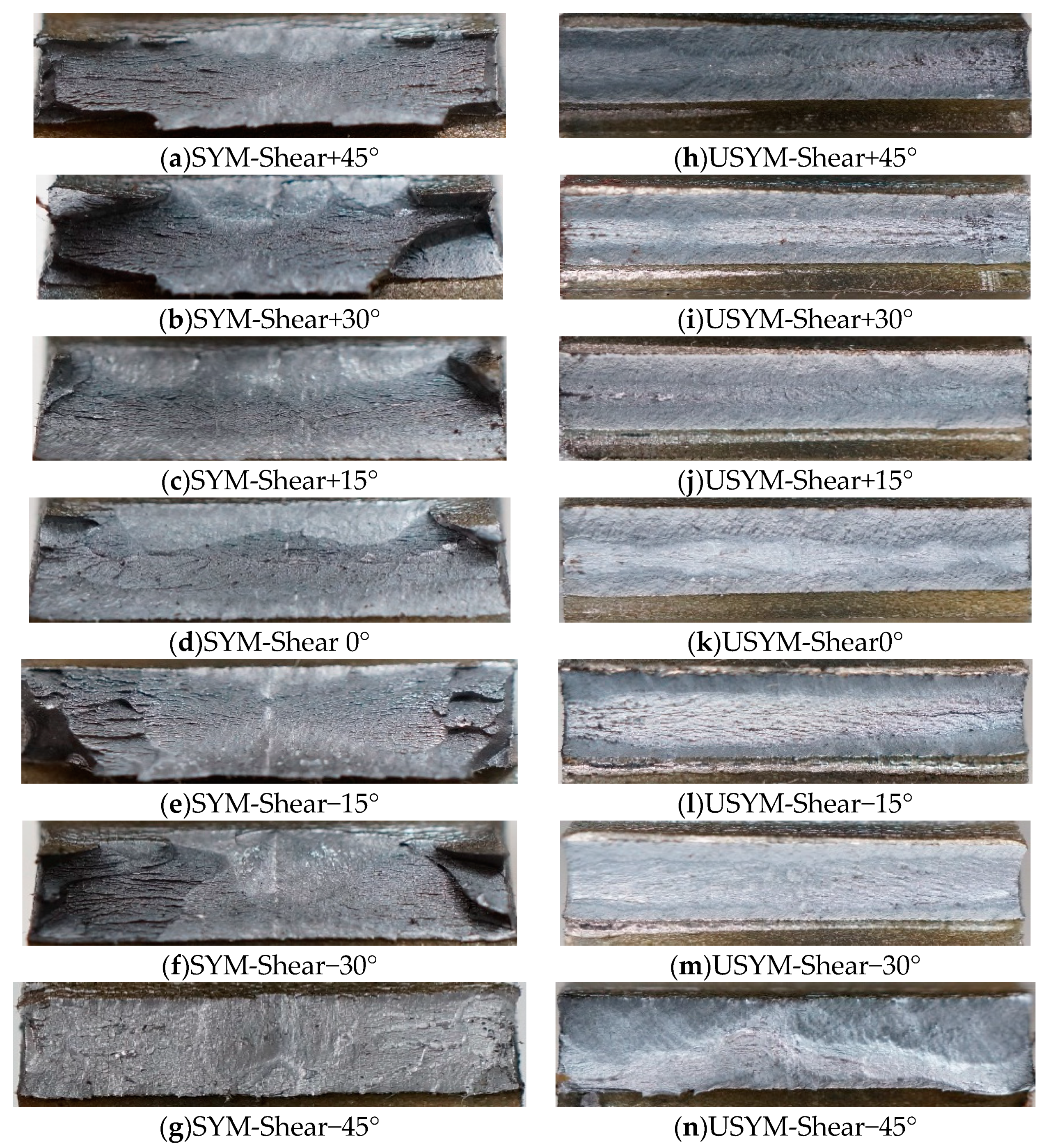

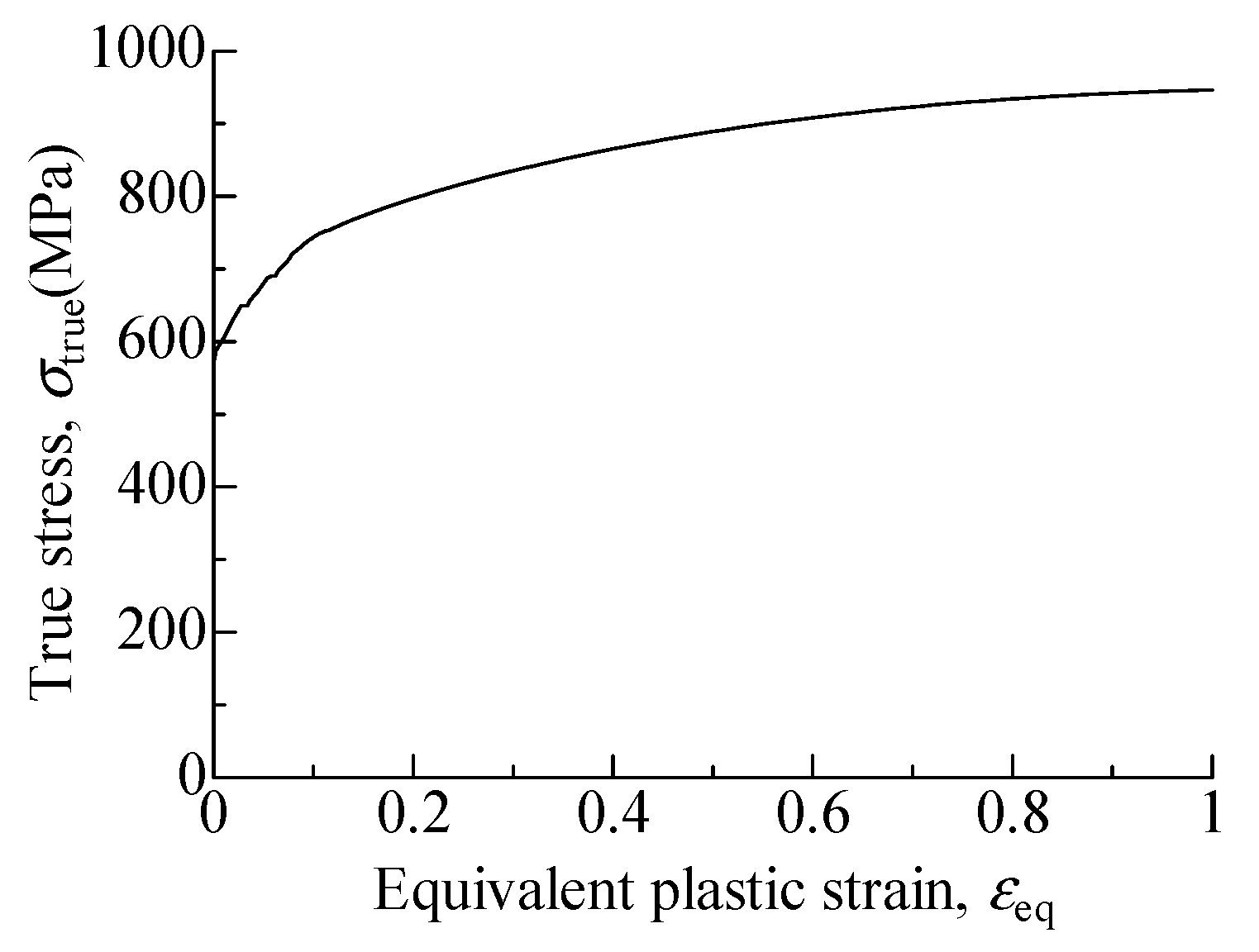
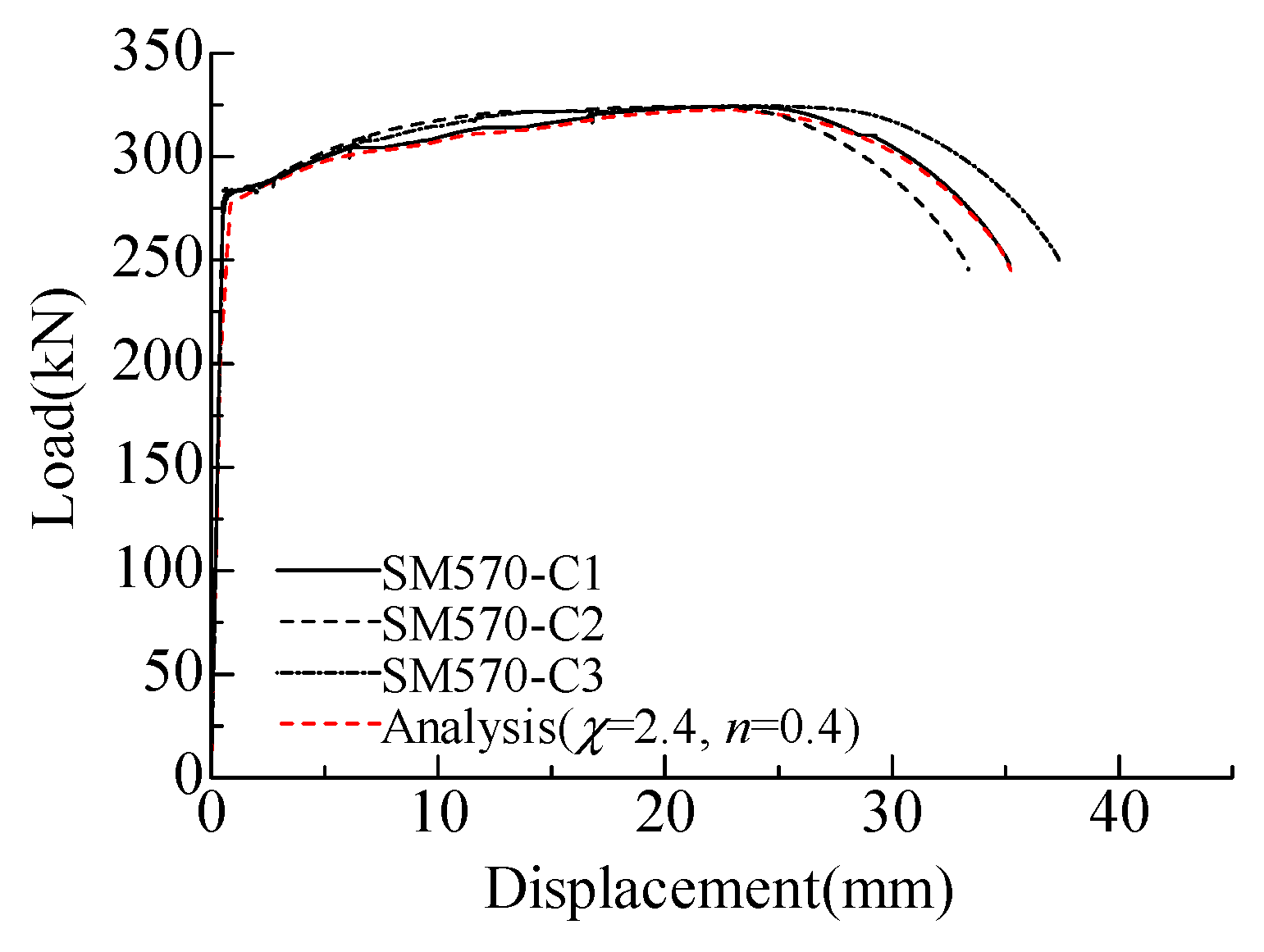

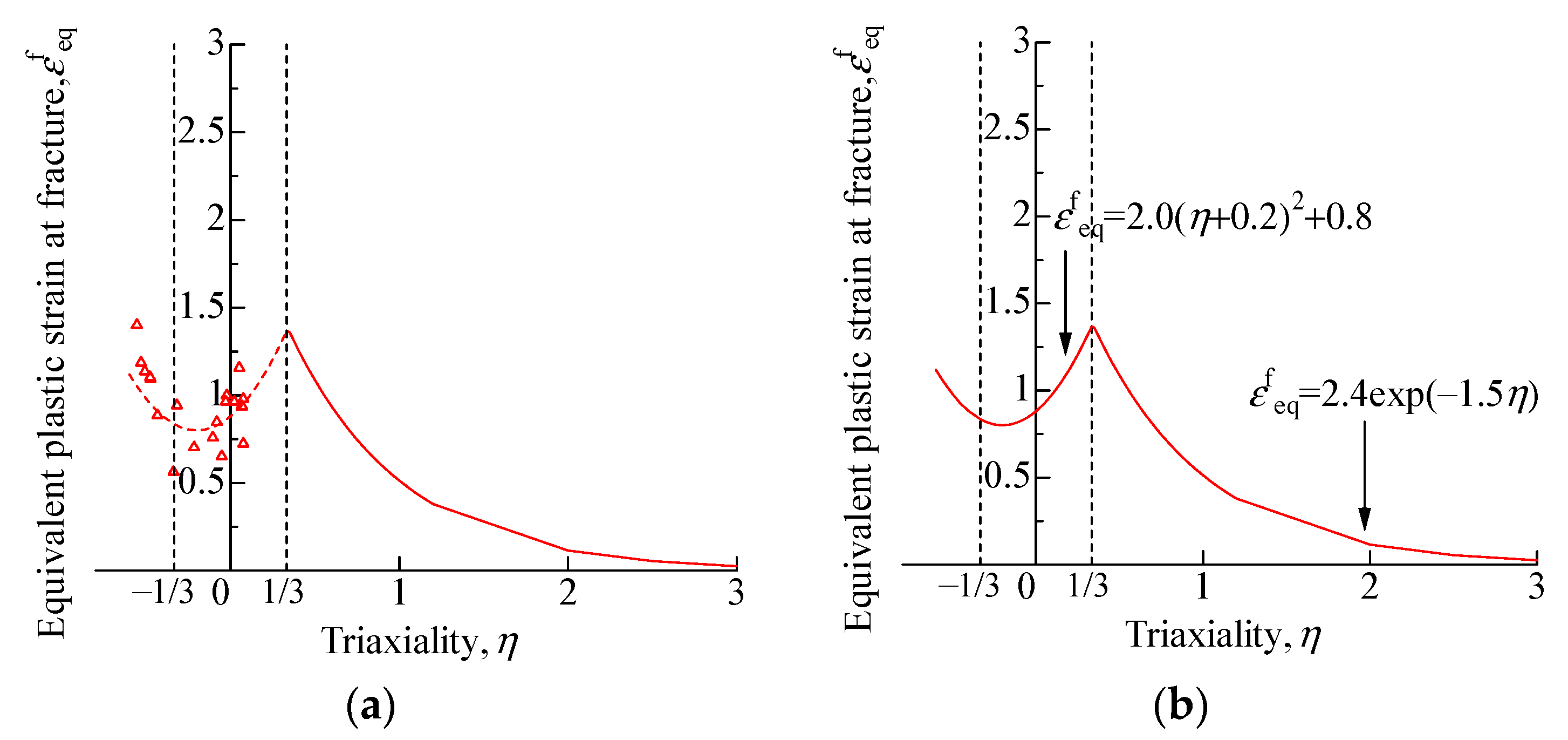
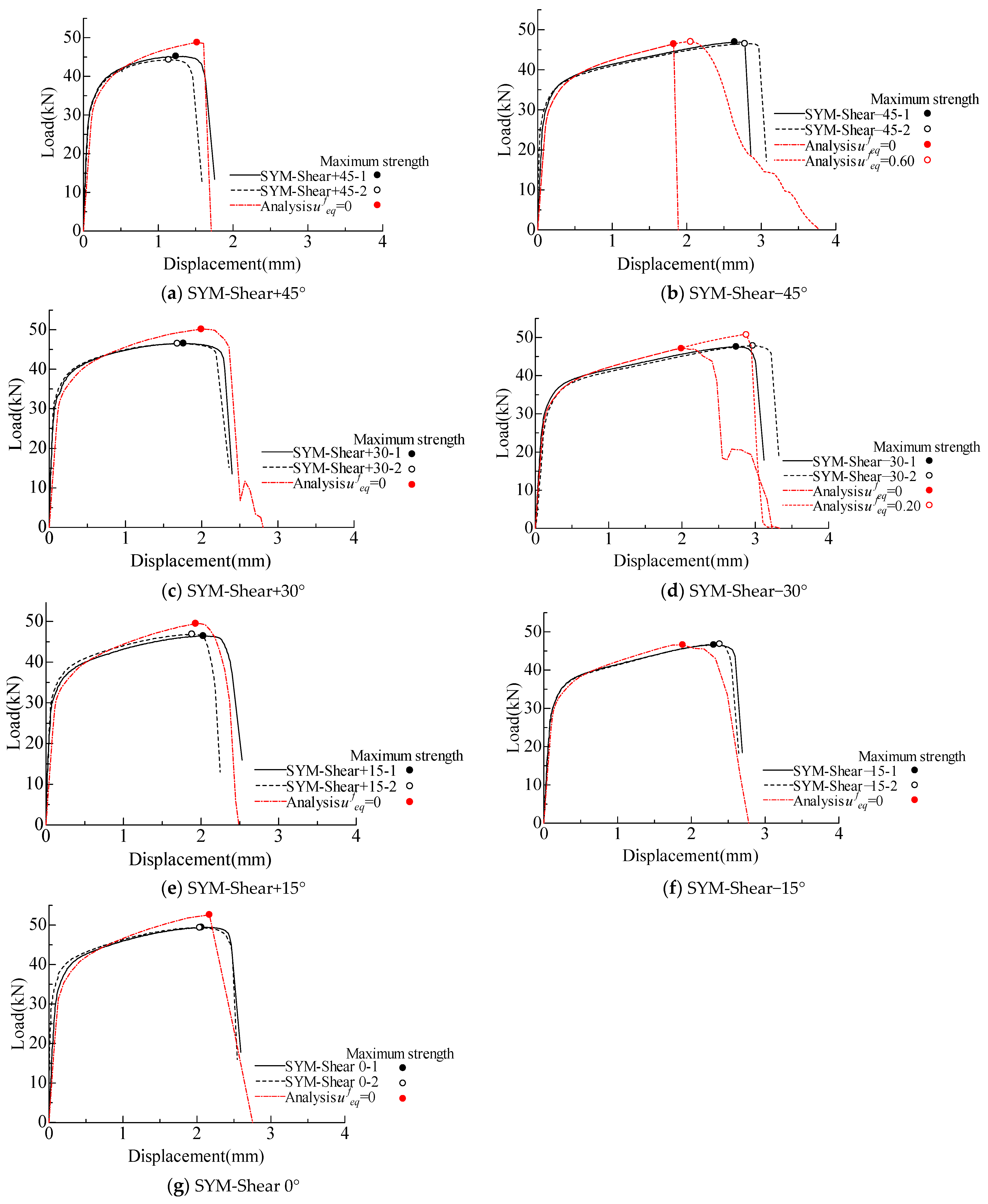
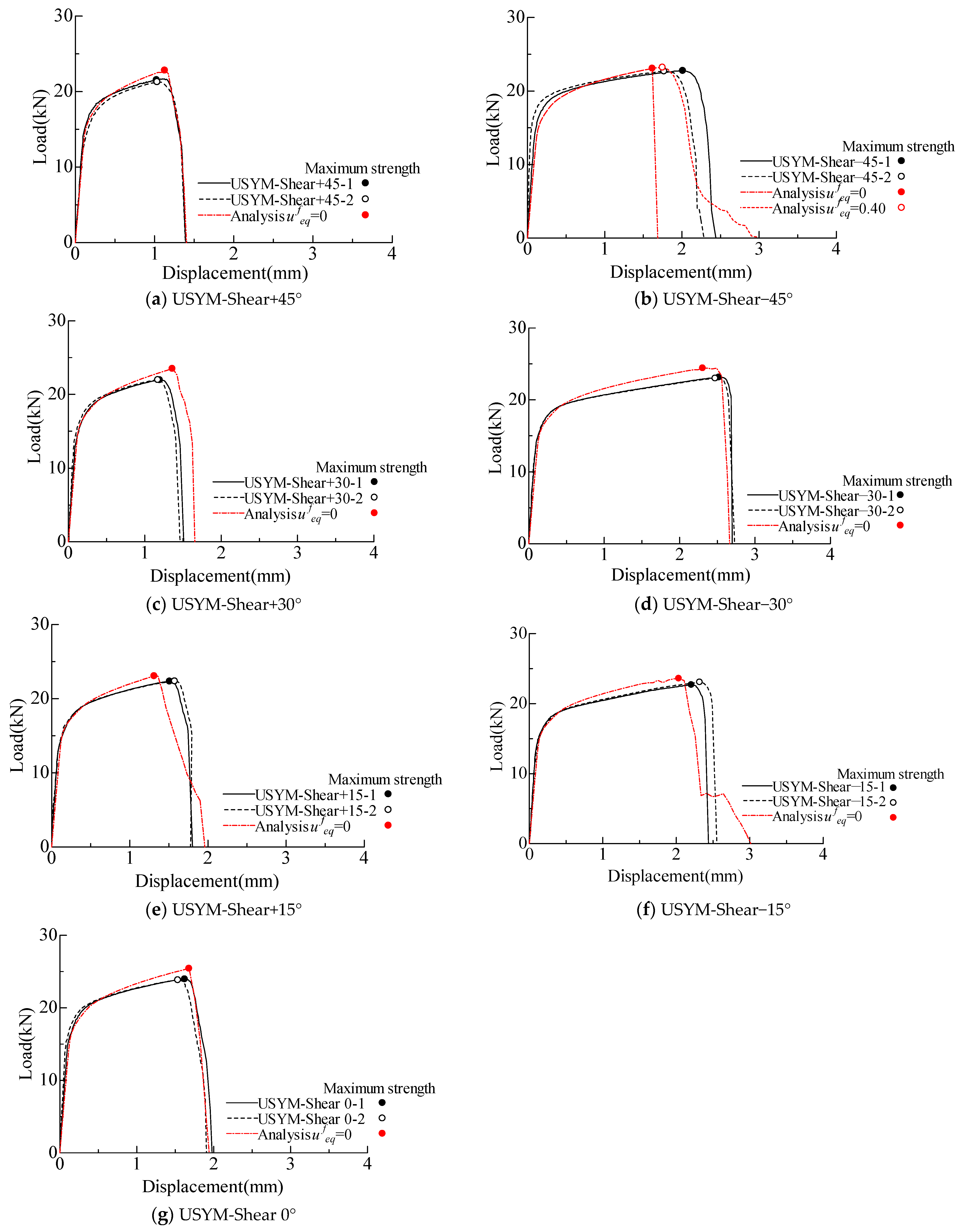
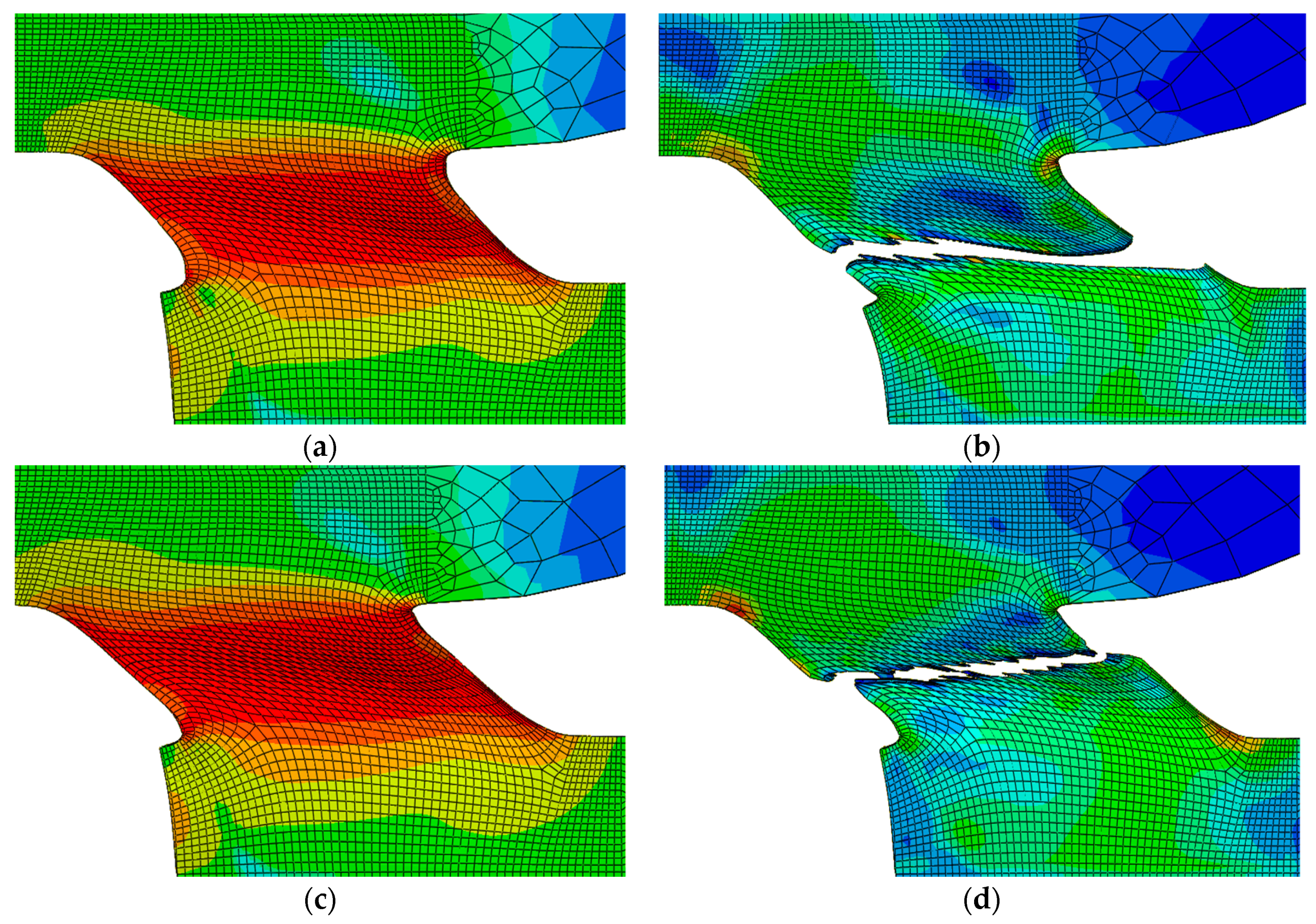
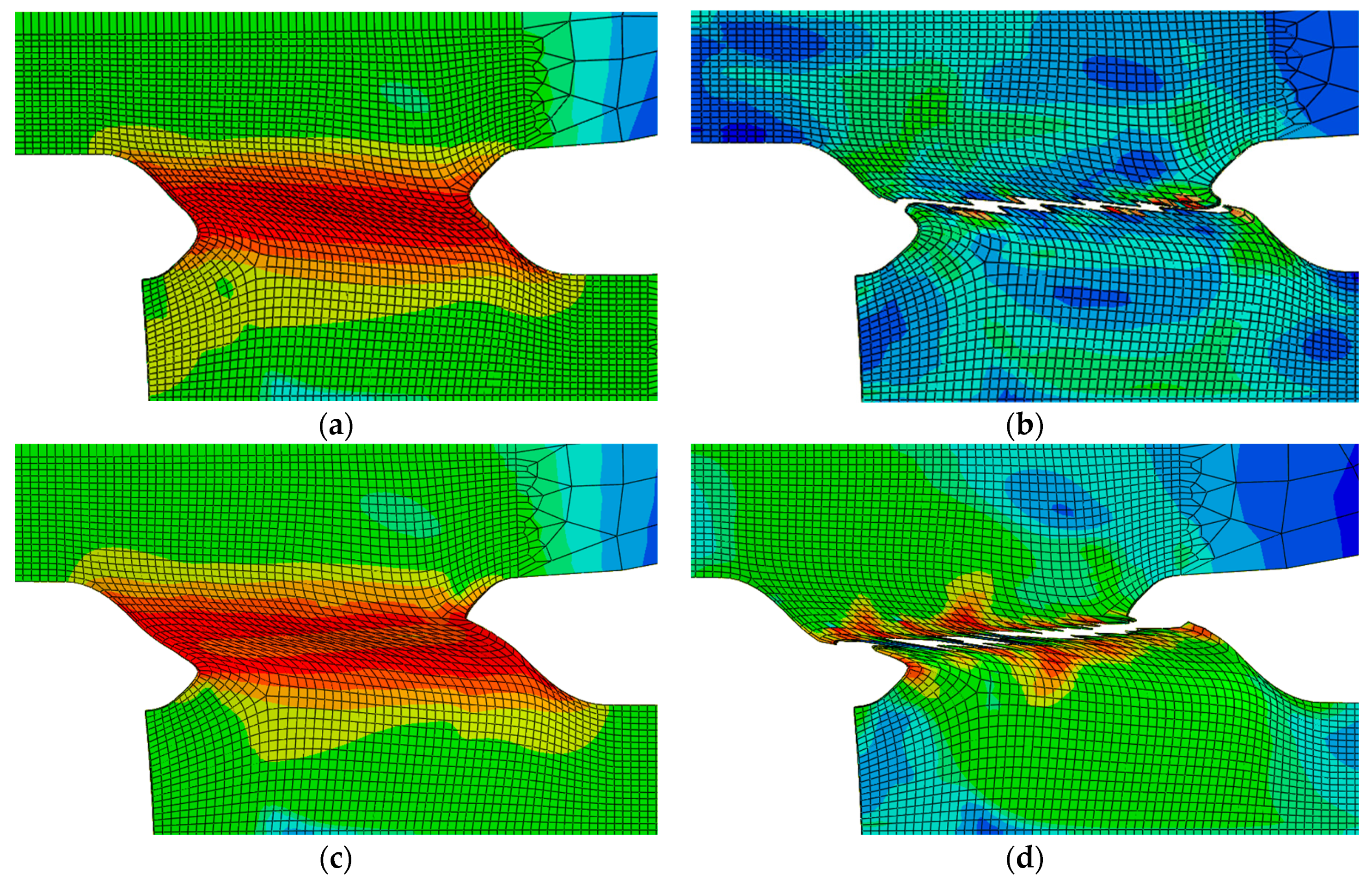
| E (GPa) 1 | ν2 | σy (MPa) 3 | εy4 | σt (MPa) 5 | δ (%) 6 | ||
|---|---|---|---|---|---|---|---|
| SM570 | Test | 200 ± 5.115 | 0.28 ± 0.020 | 586 ± 7.330 | 0.0027 ± 0.001 | 673 ± 2.231 | 17.66 ± 1.03 |
| Standard | - | - | Over 460 | - | 570~720 | - | |
| Pmax (kN) 1 | δmax (mm) 2 | δf (mm) 3 | |
|---|---|---|---|
| SYM-Shear+45 | 45.21 | 1.24 | 2.25 |
| SYM-Shear+30 | 46.55 | 1.76 | 2.59 |
| SYM-Shear+15 | 46.42 | 2.03 | 2.86 |
| SYM-Shear 0 | 49.42 | 2.06 | 2.78 |
| SYM-Shear−15 | 46.60 | 2.30 | 3.28 |
| SYM-Shear−30 | 47.58 | 2.74 | 3.73 |
| SYM-Shear−45 | 46.95 | 2.64 | 3.14 |
| USYM-Shear+45 | 21.69 | 1.12 | 1.41 |
| USYM-Shear+30 | 21.96 | 1.20 | 1.51 |
| USYM-Shear+15 | 22.33 | 1.51 | 1.80 |
| USYM-Shear 0 | 23.96 | 1.62 | 1.98 |
| USYM-Shear−15 | 22.68 | 2.21 | 2.44 |
| USYM-Shear−30 | 23.13 | 2.52 | 2.70 |
| USYM-Shear−45 | 22.77 | 2.01 | 2.44 |
| Left 3 | Right 4 | Left | Right | |
|---|---|---|---|---|
| SYM-Shear+45° | −0.052 | −0.105 | 0.652 | 0.760 |
| SYM-Shear+30° | −0.317 | −0.217 | 0.943 | 0.703 |
| SYM-Shear+15° | −0.476 | −0.530 | 1.104 | 1.186 |
| SYM-Shear 0° | −0.023 | −0.081 | 1.000 | 0.848 |
| SYM-Shear−15° | −0.508 | −0.555 | 1.137 | 1.402 |
| SYM-Shear−30° | 0.069 | 0.022 | 0.936 | 0.964 |
| SYM-Shear−45° | 0.052 | −0.029 | 1.157 | 0.964 |
| USYM-Shear+45° | −0.338 | 0.563 | ||
| USYM-Shear+30° | −0.433 | 0.887 | ||
| USYM-Shear+15° | −0.473 | 1.093 | ||
| USYM-Shear 0° | 0.076 | 0.979 | ||
| USYM-Shear−15° | 0.076 | 0.724 | ||
| USYM-Shear−30° | 0.065 | 0.938 | ||
| USYM-Shear−45° | 0.051 | 1.156 | ||
| Pmax (kN) 1 | δmax (mm) 2 | Error (Pmax) 3 | Error (δmax) 4 | |
|---|---|---|---|---|
| SYM-Shear+45° | 48.76 | 1.51 | 7.85% | 21.77% |
| SYM-Shear+30° | 50.16 | 1.99 | 7.76% | 13.07% |
| SYM-Shear+15° | 49.47 | 1.93 | 6.57% | −4.93% |
| SYM-Shear 0° | 52.60 | 2.16 | 6.43% | 4.85% |
| SYM-Shear−15° | 46.61 | 1.88 | 0.02% | −18.26% |
| SYM-Shear−30° | 47.25 | 2.01 | −0.69% | −26.64% |
| SYM-Shear−45° | 46.45 | 1.82 | −1.06% | −31.06% |
| USYM-Shear+45° | 22.81 | 1.12 | 5.16% | 0.00% |
| USYM-Shear+30° | 23.32 | 1.30 | 6.19% | 8.33% |
| USYM-Shear+15° | 23.05 | 1.31 | 3.22% | −13.25% |
| USYM-Shear 0° | 25.42 | 1.68 | 6.09% | 3.70% |
| USYM-Shear−15° | 23.60 | 2.03 | 4.06% | −8.14% |
| USYM-Shear−30° | 24.40 | 2.31 | 5.49% | −8.33% |
| USYM-Shear−45° | 23.07 | 1.62 | 1.32% | −19.40% |
| = 0.6) | 50.71 | 2.87 | 6.58% | 4.74% |
| = 0.2) | 46.99 | 2.05 | 0.09% | −22.35% |
| = 0.4) | 22.94 | 1.82 | 0.75% | −9.45% |
Publisher’s Note: MDPI stays neutral with regard to jurisdictional claims in published maps and institutional affiliations. |
© 2022 by the authors. Licensee MDPI, Basel, Switzerland. This article is an open access article distributed under the terms and conditions of the Creative Commons Attribution (CC BY) license (https://creativecommons.org/licenses/by/4.0/).
Share and Cite
Liu, Y.; Ikeda, S.; Liu, Y.; Ge, H. Ductile Fracture Investigation of High-Strength Steel SM570 under Low Stress Triaxiality. Metals 2022, 12, 1394. https://doi.org/10.3390/met12081394
Liu Y, Ikeda S, Liu Y, Ge H. Ductile Fracture Investigation of High-Strength Steel SM570 under Low Stress Triaxiality. Metals. 2022; 12(8):1394. https://doi.org/10.3390/met12081394
Chicago/Turabian StyleLiu, Yan, Shuto Ikeda, Yanyan Liu, and Hanbin Ge. 2022. "Ductile Fracture Investigation of High-Strength Steel SM570 under Low Stress Triaxiality" Metals 12, no. 8: 1394. https://doi.org/10.3390/met12081394
APA StyleLiu, Y., Ikeda, S., Liu, Y., & Ge, H. (2022). Ductile Fracture Investigation of High-Strength Steel SM570 under Low Stress Triaxiality. Metals, 12(8), 1394. https://doi.org/10.3390/met12081394








